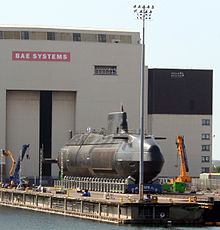| Nuclear submarine | |
|---|---|
 British Astute-class submarine | |
| Classification | Watercraft |
| Industry | Arms |
| Application | Underwater warfare |
| Invented | 1955[1] |
A nuclear submarine is a submarine powered by a nuclear reactor, but not necessarily nuclear-armed. Nuclear submarines have considerable performance advantages over "conventional" (typically diesel-electric) submarines. Nuclear propulsion, being completely independent of air, frees the submarine from the need to surface frequently, as is necessary for conventional submarines. The large amount of power generated by a nuclear reactor allows nuclear submarines to operate at high speed for long periods, and the long interval between refuelings grants a virtually unlimited range, making the only limits on voyage times being factors such as the need to restock food or other consumables.[2] The limited energy stored in electric batteries means that even the most advanced conventional submarine can remain submerged for only a few days at slow speed, and only a few hours at top speed, though recent advances in air-independent propulsion have somewhat ameliorated this disadvantage. The high cost of nuclear technology means that relatively few of the world's military powers have fielded nuclear submarines. Radiation incidents have occurred within the Soviet submarines, including serious nuclear and radiation accidents, but American naval reactors starting with the S1W and iterations of designs have operated without incidents since USS Nautilus (SSN-571) launched in 1954.[3][4]
- ^ Delgado (2011), p. 200.
- ^ Trakimavičius, Lukas. "The Future Role of Nuclear Propulsion in the Military" (PDF). NATO Energy Security Centre of Excellence. Retrieved 15 October 2021.
- ^ Cite error: The named reference
johnston2007was invoked but never defined (see the help page).